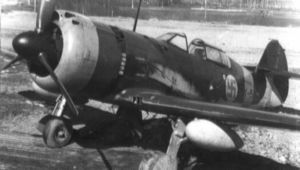VL Myrsky Video - Picture

|
|
VL Myrsky
Myrsky

Picture - A VL Myrsky fighter
Role: Reconnaissance/fighter
Manufacturer: Valtion lentokonetehdas
Designed by: Edward Wegelius, Martti Vainio and Torsti Verkkola
First flight: 1941
Introduced: 1943
Retired: 1947
Status: Retired
Primary user: Finnish Air Force
Number built: 51
VL Myrsky (English: Storm) was a Finnish World War II fighter, designed by the State Aircraft Factory (Valtion lentokonetehdas) for the Finnish Air Force. The models of the aircraft were Myrsky I, Myrsky II, and Myrsky III.
History
The decision to start developing a new fighter for the Finnish Air Force was based on experience gained before the Winter War: in the "arms race" leading up to a war, it can be difficult for smaller nations to purchase top-of-the-range fighters without a significant political cost. The Finnish Air Force ordered premilinary proposal for domestic fighter from State Aircraft Factory (Valtion Lentokonetehdas) before Winter War early 1939. State Aircraft Factory prepared five alternative proposals May 1939. After that, The Ministry of Defence ordered the design of fighter from State Aircraft Factory June 1939.
The premilinary design was made by the aircraft-designer trio Arvo Ylinen (head of the design-bureau), Martti Vainio (aerodynamics), and Torsti Verkkola (structural design). Edward Wegelius was appointed head of the design department of the State Aircraft Factory when Ylinen later moved on to the Helsinki University of Technology in August 1940. VL did not appoint any main constructor to its products, such as the German aircraft manufacturers did.
Due to difficulties obtaining duraluminium, the wings were made out of plywood and the fuselage was metal structure with fabric or plywood coating. The planned Bristol Taurus III engine was not available due to war, so a Pratt & Whitney R-1830 (civil Twin Wasp) was chosen, instead: an R-1830-S3C3-G for the first prototype, less-powerful SC3-Gs for later prototypes and production fighters from Germany (war booty).
The first Myrsky I prototype flew on 23 December 1941. The prototype was fully functional, but too heavy. After some modifications they soon had three new prototype aircraft. The test flights showed some problems with the structural strength during high speed tests. All three prototypes were destroyed during test flights; two test pilots died, one was seriously injured.
Series production started after German deliveries of Messerschmitt Bf 109 had begun in 1943. The series production version was called Myrsky II. 47 Myrsky IIs were built and together with the Myrsky I version the production amounted to 51 in all. Although the aircraft met the specifications set for it, it did not fulfill all expectations due to structural problems.
The Myrsky III was ordered in spring 1943, but none were built.
Operational history
Reconnaissance Squadron 12 received first Myrskys during August 1944. Thirty Myrskys were delivered to Reconnaissance Squadrons 12 and 16 before the end of Continuation War.
Fifteen Myrsky fighters flew 68 missions during Continuation War. During one mission, they met Soviet Yak-7s, but the fight ended without losses for either side. During two other missions, Myrskys damaged two Soviet fighters. Six Myrskys took part in a bombing mission on September 3, 1944.
During the Lapland War, six Myrskys flew 13 reconnaissance missions between March 2 and March 23, 1944. The wooden construction proved problematic in this theatre, not enduring wet weather or cold well. The war time Lukko glue, manufactured from ersatz materials, which was used on glueing the wood parts, did not stand rain, frost and humidity, and the glue seams disintegrated, sometimes with disastrous results.
Ten Myrskys were lost in accidents between 1943-1947 and four pilots died. Myrsky usage ended in May 1947 and the last Myrsky flight was in February 1948.
Versions
Myrsky I Prototype aircraft, 4 built Myrsky II Series-production aircraft, 47 built Myrsky III none built
Operators
Finland Finnish Air Force
Specifications (VL Myrsky)
General characteristics
Crew: One
Length: 8.35 m (27 ft 5 in)
Wingspan: 11.00 m (36 ft 1 in)
Height: 3.00 m (9 ft 10 in)
Wing area: 18.00 m² (193.7 ft²)
Empty weight: 2,485 kg (5,480 lbs)
Max takeoff weight: 3,213 kg (7,080 lbs)
Powerplant: 1x— Pratt & Whitney R-1830-SC3-G Twin Wasp 14-cyl., 749 kW (1,065 hp)
Performance
Maximum speed: 535 km/h
Service ceiling: 9,500 m ()
Rate of climb: 15 m/s (50 ft/s)
Power/mass: 3.0 kg/hp (6.6 lb/hp)
Armament
4x— 12,7 mm LKK/42 machine guns
2x— 100 kg bombs
Bibliography
Green, William. War Planes of the Second World War, Fighters, Volume One. London: Macdonald & Co.(Publishers) Ltd., 1960. ISBN 0-356-01445-2.
Stemman, Karl. "Finland's Fighter Finale". Air Enthusiast. Issue 23, December 1983-March 1984. Bromley, Kent UK: Pilot Press, 1983. pp.10-19, 80.
VL Myrsky Pictures
More aircraft.
Source: WikiPedia